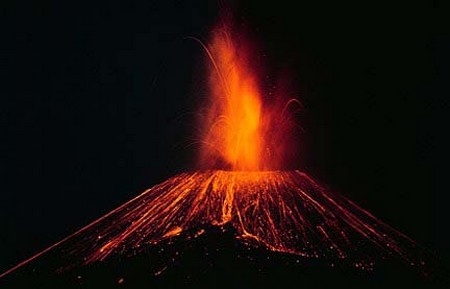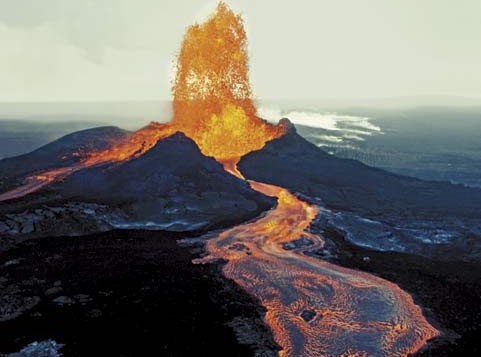A mountain or hill came into being by the accrual of materials broke out through the Earth’s surface is known as volcano. A bowl shaped pit (crater) is linked to the magma chamber though pipe like openings, known as volcanic vents.
Excessive heat and pressure within the earth is responsible for the rock melting, which eventually result in the formation of volcanoes. The molten rock (magma) looses its grip and become less compact than the surrounding solid rock and forces its way up towards the earth’s surface. This results in volcanic eruptions in the form of lava (magma that reaches the earth’s surface), ash, debris, gas. Eruptions are normally explosive or silent/quiet. The quiet eruptions usually involve the overspill of lava or gas.
There are several volcanoes exist on earth. Out of these several volcanoes, few are considered active and others are considered inactive (dormant volcanoes). Dormant or inactive volcanoes are those which have not erupted in hundreds of years, but they can erupt anytime. There are volcanoes which have not erupted in thousands of years and are thought extinct and the probability is that they won’t become active again. Under the sea water, there are more than 5,000 active volcanoes and the numbers reach to 800, if we talk about the active volcanoes that exist above the sea level.
Different Kinds of Volcanoes
Shield Volcanoes
Shield volcanoes are considered as the largest volcanoes on the surface of the earth. Shallow-sloping sides are the distinct feature of the shield volcanoes. These slopes help lava of low thickness (viscosity) to flow easily through the fissures made on sloping sides. The continuous flow of the basaltic lava from the fissures results in the formation of the huge volcanic mountain.
Mauna Loa is the largest active volcano on the surface of the earth which is situated with its base under the ocean in Hawaii. There are many other shield volcanoes found in Hawaiian Islands. These volcanic mountains often refer to as mountain range for their gigantic size. The highest temperature of the shield volcanic magma ever recorded is 1200oC in Hawaiian Islands.
Composite Volcanoes
Composite volcanoes are the most common type of volcanoes having a tall conical structure. Composite volcanoes are also known as Strato volcano because of the formation of a series of layers (strata) of hardened lava, tephra and volcanic ash caused by successive outpourings. Periodic explosive eruptions are associated with these volcanoes. The low viscosity lava outpouring from the composite volcano cools down and become hard.
Composite volcanoes as we have said earlier are often explosive because of the fact that the low lava of low viscosity blocks the carter pipe which as a result increases the pressure within the carter pipe and eventually results in an explosive eruption. Some of the major composite volcanoes include Mount Hood, Mount Rainier, Mount Shasta, Mount Fugi, Mount Mayon and Vesuvius.
Cinder Cone Volcanoes
Cinder cone volcano is also known as scoria cone. The name is given to them because of their structure that involves a steep conical hill of volcanic fragments known as cinders. The cinder cone volcanoes are described by accrual of volcanic fragments encircling the volcanic vent and going along the downwind. The volcanic fragments have a numerous gas bubbles frozen into place. The height of the cinder cone volcanoes can be somewhere around ten to hundreds meters.
On the top, most of the cinder cone volcanoes have a bowl shaped pit known as carter. The lava flows from only one side of the carter. However, the lava can also be developed from a vent situated on the edge of the volcano. One of the most popular cinder cone volcanoes is Paricutin, appeared for the first in a corn field in Mexico in 1943. Currently, the Cerro Negro located in Nicaragua has been known as the most active volcano of this type. Cinder cone volcanoes are usually located on the edges of the shield and composite volcanoes.





